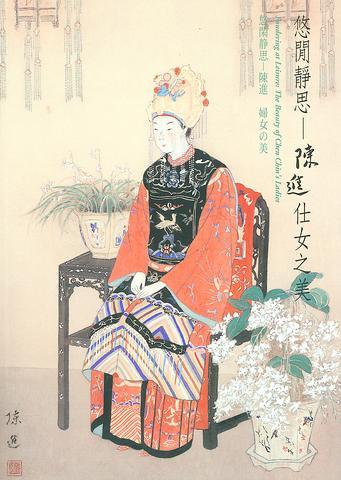Over the coming month, the National Museum of History will be showcasing a selection of works by one of Taiwan's earliest, most celebrated and influential female artists, Chen Chin (
Born in Hsinchu in 1907, Chen was the first Taiwanese female artist to study in Japan. She studied at the Tokyo Fine Arts Girls School under the guidance of some of Japan's leading artists. Even at such a young age her works were so sought after and her style so respected that critics dubbed her "the female genius of the Southern Sea."

PHOTO COURTESY OF NATIONAL MUSEUM OF HISTORY
Chen's repertoire included landscapes and still-life, but it was her portraits of ladies and her ability to transform a painting into an image that incorporated a genuine feel for the era in which they were created that was to prove her enduring legacy.
By the time she passed away in 1998, Chen had become not only one of Taiwan's most prominent and eminent artists, but her works were taking pride of place in museums and galleries throughout Europe and the Americas.
Incorporating 32 of her works dating from 1932 through 1998, The Beauty of Chen Chin's Ladies (
Beginning with Modern Lady, the exhibition takes the viewer through Chen's early unmarried days form between 1925 and 1945. Her eye for detail saw her create works that depicted both the fashions, hairstyles as well as the mannerisms and moods of young ladies of the day.
Works such as her celebrated 1936 Applying Make-up (
The latter part of the exhibition, Traditional Mother deals with Chen's works from 1945 through 1998. Here viewers see how Chen's marriage, motherhood and life as a grandmother changed her outlook on both life and art and saw her style changing in subtle yet noticeable ways.
In later works such as 1968's Fragrant Orchids (
Regardless of which chapter of Chen's life the viewer chooses to enjoy, the current exhibition gives a highly appealing overview of not only the life of one of Taiwan's foremost artists. It is also an interesting insight into the changing fashions and mannerisms of Taiwanese women as see through Chen's eyes.
The Beauty of Chen Chin's Ladies (

April 14 to April 20 In March 1947, Sising Katadrepan urged the government to drop the “high mountain people” (高山族) designation for Indigenous Taiwanese and refer to them as “Taiwan people” (台灣族). He considered the term derogatory, arguing that it made them sound like animals. The Taiwan Provincial Government agreed to stop using the term, stating that Indigenous Taiwanese suffered all sorts of discrimination and oppression under the Japanese and were forced to live in the mountains as outsiders to society. Now, under the new regime, they would be seen as equals, thus they should be henceforth

Last week, the the National Immigration Agency (NIA) told the legislature that more than 10,000 naturalized Taiwanese citizens from the People’s Republic of China (PRC) risked having their citizenship revoked if they failed to provide proof that they had renounced their Chinese household registration within the next three months. Renunciation is required under the Act Governing Relations Between the People of the Taiwan Area and the Mainland Area (臺灣地區與大陸地區人民關係條例), as amended in 2004, though it was only a legal requirement after 2000. Prior to that, it had been only an administrative requirement since the Nationality Act (國籍法) was established in

With over 80 works on display, this is Louise Bourgeois’ first solo show in Taiwan. Visitors are invited to traverse her world of love and hate, vengeance and acceptance, trauma and reconciliation. Dominating the entrance, the nine-foot-tall Crouching Spider (2003) greets visitors. The creature looms behind the glass facade, symbolic protector and gatekeeper to the intimate journey ahead. Bourgeois, best known for her giant spider sculptures, is one of the most influential artist of the twentieth century. Blending vulnerability and defiance through themes of sexuality, trauma and identity, her work reshaped the landscape of contemporary art with fearless honesty. “People are influenced by

Three big changes have transformed the landscape of Taiwan’s local patronage factions: Increasing Democratic Progressive Party (DPP) involvement, rising new factions and the Chinese Nationalist Party’s (KMT) significantly weakened control. GREEN FACTIONS It is said that “south of the Zhuoshui River (濁水溪), there is no blue-green divide,” meaning that from Yunlin County south there is no difference between KMT and DPP politicians. This is not always true, but there is more than a grain of truth to it. Traditionally, DPP factions are viewed as national entities, with their primary function to secure plum positions in the party and government. This is not unusual